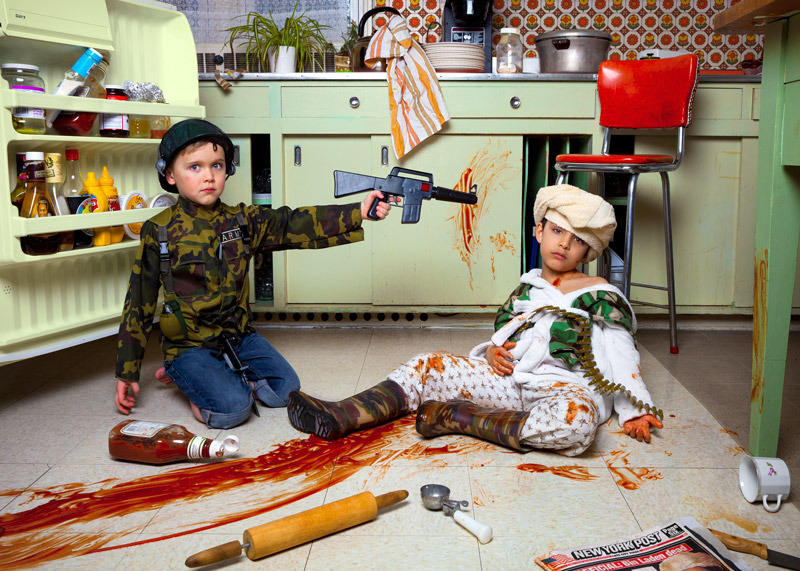Thus far with “Wanting Images”, I have explored W.J.T. Mitchell’s query “What do pictures really want”1 in relation to practices of image making that one might describe as documentary or photojournalistic. With this entry I shift the focus to a series of images by Ottawa-based artist Jonathan Hobin, whose carefully staged reinterpretations of iconic scenes from the news media blur the boundaries between document and artifice. His series In the Playroom, exhibited at White Water Gallery in 2011 and featured at the 2013 Scotiabank Photography Festival, has garnered significant critical attention, most notably for his use of child models to re-enact tableaus of well-publicized global events, such as the killing of Osama Bin Laden by US military forces (Got Him) and acts of torture perpetrated by US military personnel against prisoners at Abu Ghraib prison in Iraq ( A Boo Grave). What happens “in the playroom” – a space dedicated to the entertainments of childhood – is seemingly at odds with Hobin’s staged portrayals in which children assume the postures of violence more typical to an adult world; and it is this juxtaposition – between the supposed innocence of youth and the culpability of adulthood – that generates the pedagogical force of his project.
We might think of pedagogy in quite simple terms: as a mode of communicative practice, for instance, through which something (a new idea, a skill, an emotional response) is learned. In the context of looking, pedagogy is often cast in this kind of instrumentalist way, where the image becomes as a “tool” to leverage a desired outcome or “lesson”, whether derived from the photograph’s representational and/or formal qualities. In my discussion of Hobin’s work, however, I’d like to offer a different pedagogical perspective, one drawn from my thinking with Mitchell. Pedagogy, I propose, is all forms of interference. What is interfered with is the fantasy that something – a person, an object, an ideal, an idea, an image, or even an answer – might be fully known or understood. The aim of pedagogy, then, is not to create “knowledge”, but instead to provoke thinking. By accepting this invitation to thought one might find a new orientation to oneself in relation to the social and political world. Images, in this sense, are not in themselves pedagogical. An image may feel didactic, giving the impression that something in particular is being taught (and here we are close to advertisement). As an enigmatic object, the image rather instantiates a pedagogical relation through which the viewer is ushered into thought. This is close to Mitchell’s view of the image as a cause that brings desire into being. It is this understanding of pedagogy that guides my thinking about Hobin’s series.
 Jonathan Hobin, Got Him (2013), from the series In The Playroom
Jonathan Hobin, Got Him (2013), from the series In The PlayroomCritical writing about “In the Playroom”, as well as Hobin’s own articulation of his project, situates the series as having distinctly pedagogical value. But what is meant by pedagogy here? Clayton Windatt writes that, “In the Playroom’s images create a unified statement about the effect that the media has on society… More than anything these images are cautionary tales compelling the audience to be more conscious of the fact that children are always listening and watching”2. With this perspective we are led to understand Hobin’s images as “cautionary tales” that build towards a “unified statement” about the relation between media and society. This is an instructional as opposed to an interpretive view of the pedagogical potential of looking, one that forecloses the question of what it is that the image might want. In Windatt’s formulation, desire is attenuated towards a developing consciousness about how children “are always listening and watching”. Hobin echoes this cautionary perspective, insisting that, “these pictures serve a purpose, as a moral, as a warning, just the way nursery rhymes did” 3. Indeed, Hobin’s method with this project seems to manifest just such a didactic approach. “I work with children”, he tells us,
…because you need to see a real child in order to get the message across; painting doesn’t work. Photography is the only way to say it…. [In the image]…[t]here is often at least one child looking back and connecting with the viewer. So you have to ask, ‘What’s wrong with this picture?’4
I am struck by Hobin’s articulation, with this statement, of his image-making practice as being concerned with getting “the message across”. Are we to think of photography, then, as a message delivery system, where the veracity of the representation (a real child) moves us in ways that painting cannot? While Hobin’s formal methods, such as the use of performative tableaus to highlight the cinematic qualities of photojournalistic images, might respond to the ongoing debates in visual culture regarding the relation between representation and the real (in the tradition, for example, of work by Jeff Wall and Sophie Calle amongst others), I’m not sure that he succeeds in moving the viewer past something that feels rather propagandistic in its approach. “So you have to ask”, he declares, “‘What’s wrong with this picture?’” Is this, in fact, the question that the viewer has to ask? On the one hand this demand is in line with Mitchell’s perspective that what the image wants is for us to go on asking, to keep on looking (more desire, greater desire!). For the artist to determine in advance what the question (as well as the answer) might be, however, thwarts the very potential for a pedagogical relation in looking. But what of the image – outside of what Hobin might want, how do his pictures provoke?
 Jonathan Hobin, A Boo Grave (2010), from the series In The Playroom
Jonathan Hobin, A Boo Grave (2010), from the series In The PlayroomOne image from the series, A Boo Grave, references photographs that appeared in the news media in 2004, depicting the torture and abuse of supposed terror suspects by US military and other governmental personnel stationed at Abu Ghraib prison in Iraq. Hobin’s tableau interprets various aspects of the original images: one child adopts a similar stance to the now infamous cigarette-in-mouth-pointing-finger pose of former US Reservist Lynndie England; another child emulates the posture of an unidentified hooded figure perched atop a cardboard box, electrical wires attached to outstretched hands; the final posed figure manifests a strange amalgam of disparate elements in seeming allusion to the image of an Iraqi detainee photographed sprawled semi-naked on the cell-block floor, a dog lead slung around his neck. Contextualizing the scene (in addition to the photograph title – A Boo Grave – which I’m assuming is a supposed play on the English pronunciation of Abu Ghraib), are common signifiers of Hallowe’en: plastic orange pumpkins, ghosts fashioned out of bed sheets, plastic skulls and masks, a dismembered limb, a jar full of pickled ‘eyes’ and dish of candies. One way to encounter and interpret A Boo Grave is to follow Hobin’s directive and ask, “‘What’s wrong with this picture?’” What I want to consider, however, is how the image both enables and forecloses the pedagogical potential of looking.
Important to note in thinking about this image in particular is that, unlike the other photographs in Hobin’s series that respond to critical events in the news media, A Boo Grave does not merely reference a popular news story. More precisely, the story was the photographs. Hobin interprets and recreates elements of these original vernacular images and therefore participates in the recirculation of images that were themselves created and circulated for nefarious social purposes. Indeed, the original images exist within an economy of looking that is directly implicated in the scenes of human degradation they purport to expose5. As such, Hobin’s image performs more than just a commentary on the relations between the media and society – it actually offers up the original scenes for consumption one more time. My worry is not about the preciousness of the original photographs but rather whether Hobin’s reinterpretation opens the possibility of a different relation to the social and political realities represented here? There are many things that bother me about A Boo Grave, not the least of which is its reliance on an irony that repeats as opposed to working through a racist and imperial dynamics of looking. While being bothered by a photograph can create a productive affective tension, I’m not convinced that’s what is happening here.
In her article “Torture and the Ethics of Photography”, Judith Butler reminds us of the “frames of recognition” through which we learn to recognize, and indeed to construct, whom we come to perceive as human6. Photographs, she, suggests, are one such frame: “they do not merely portray or represent, but they relay affect”7. Affect is an expression that is both somatic (of the body) and psychical (of the mind). Though close to emotion, affect is that which has not yet been named as such. A tension seeking discharge or release, affect therefore carries a force that in Andre Green’s terms “snatches the body from silence”8. Shock, for example, might be one articulation of affect. With respect to A Boo Grave, I get the impression that Hobin is attempting to shock the viewer into thought. But affect is a wild thing, not so easily tamed by the photographic frame. Here is my question: does the image put shock into the service of thinking (if it is even possible to do so), and if so, is that a good enough reason to re-circulate the scenes of dehumanization that the photograph both represents and constructs? Let us follow Hobin’s instructive and ask a further question – “what’s wrong with this picture?” For Butler, our critical looking must consider how the photographic frame reproduces non-seeing in a way that becomes a visual (and national) norm. Does A Boo Grave help us “to learn to see the frame that blinds us to what we see”9, thereby altering the frames of recognition through which we encounter each other as human? The images from In the Playroom may be parables that relay a warning about how we come to read visual culture in relation to media portrayals of global violence. In this sense they provide an answer to a question that we might not have previously asked. But I want more from my looking: instead of an instruction I prefer an invitation to thought. Mitchell poses the following query that I think is relevant here: “If one could interview all the pictures one encounters in a year, what answers would they give?”10 For Hobin the answer might be the creative works that constitute In the Playroom. As for myself, I’m still thinking.
1. W.J.T. Mitchell. What Do Pictures “Really” Want? October, 77. (Summer, 1996), 71-82. ↩
2. http://www.imagearts.ryerson.ca/dsnyder/essays/johnathanhobin.pdf↩
3. http://www.imagearts.ryerson.ca/dsnyder/essays/johnathanhobin.pdf↩
4. http://www.imagearts.ryerson.ca/dsnyder/essays/johnathanhobin.pdf↩
5. For more on the circumstances surrounding the circulation of the images see Errol Morris’s excellent documentary Standard Operating Procedure (2008)↩
6. Judith Butler. Torture and the Ethics of Photography. Environment and Planning D: Society and Space (25) 6: 951-966.↩
7. Judith Butler. Torture and the Ethics of Photography. p. 954.↩
8. Green, A. 1999. The fabric of affect in the psychoanalytic discourse. London: Routledge. p. 8. ↩
9. Judith Butler. Torture and the Ethics of Photography. p. 964.↩
10. W.J.T. Mitchell. What Do Pictures “Really” Want? October, 77. (Summer, 1996), 76. ↩

